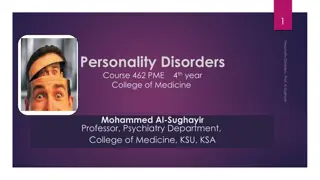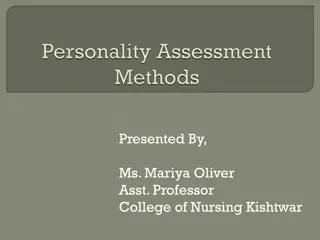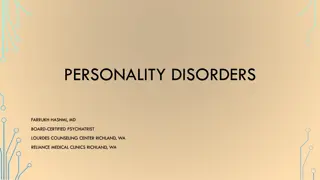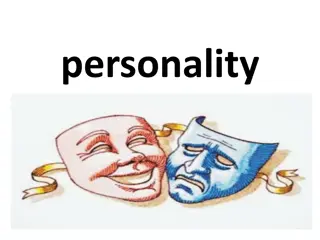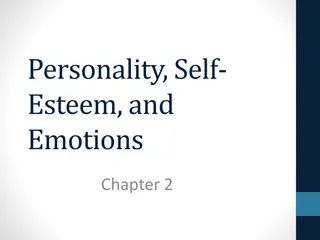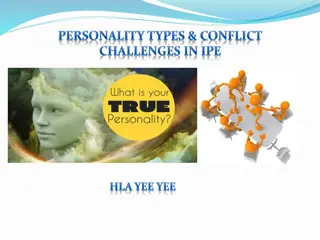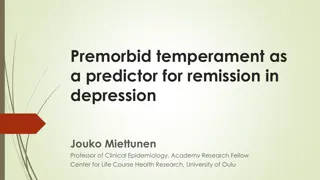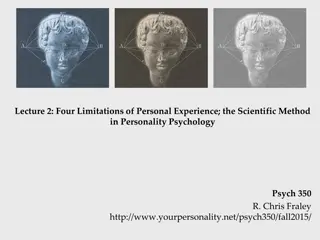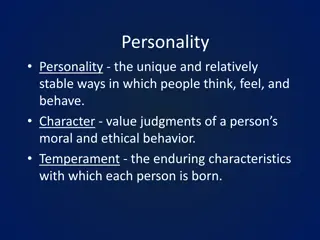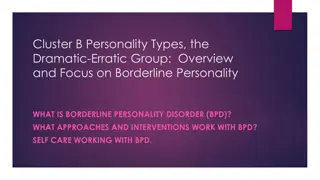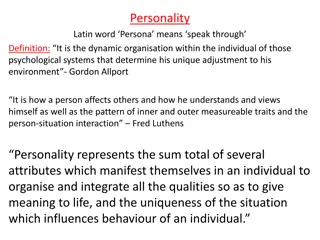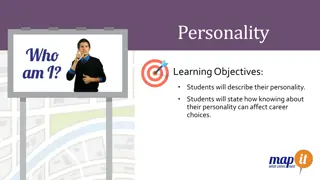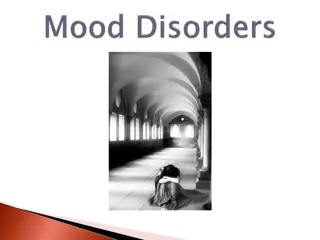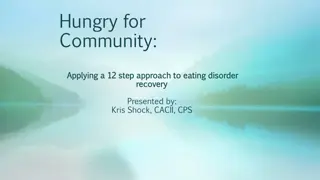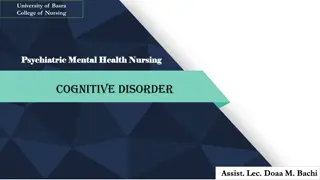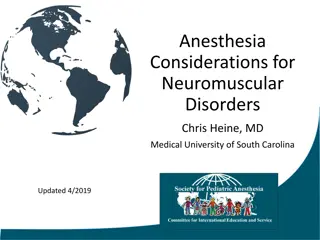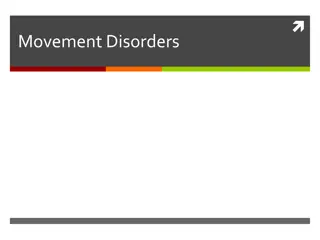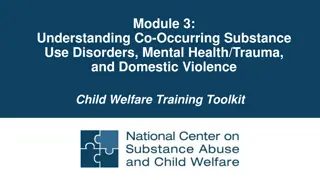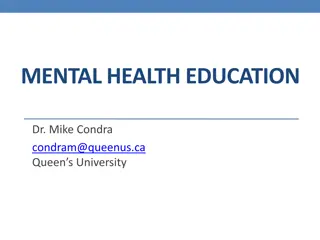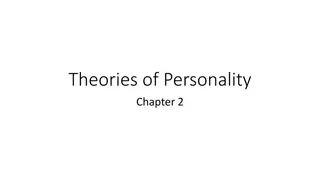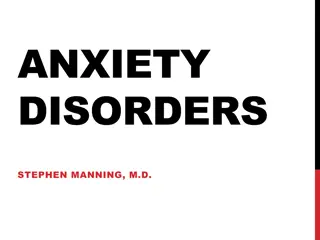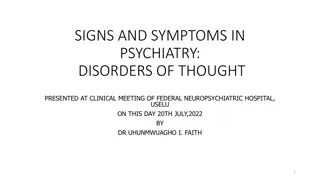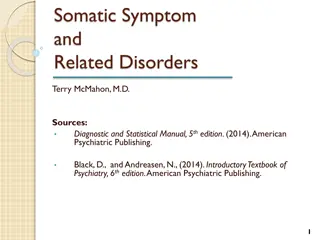Understanding Personality Disorders: An Overview
Personality disorders are chronic and maladaptive patterns of thinking, feeling, and behaving that negatively impact interpersonal relationships. Those affected often do not recognize their behaviors as problematic. Differentiating between personality disorders and traits is crucial for diagnosis and treatment. The history, epidemiology, and associated challenges of personality disorders highlight the need for greater awareness and support.
Download Presentation

Please find below an Image/Link to download the presentation.
The content on the website is provided AS IS for your information and personal use only. It may not be sold, licensed, or shared on other websites without obtaining consent from the author. Download presentation by click this link. If you encounter any issues during the download, it is possible that the publisher has removed the file from their server.
E N D
Presentation Transcript
+ Personality Disorders An Introduction Maxym Choptiany, MD FRCPC
+What is a personality disorder? Chronic, inflexible, and maladaptive pattern of relating to the world. Evident in the way a person thinks, feels, and behaves. The most noticeable and significant feature is their negative effect on interpersonal relationships. Relationships they do form are often fraught with problems and difficulties.
+What is a personality disorder? Often those with personality disorders who experience difficulties in their relationships or in their functioning don t believe that there is anything wrong with them (egosyntonic). If anything, believe society (not them) should change alloplastic thinking. As a result maladaptive behaviour is repeated.
+What is a personality disorder? Differ from personality traits (ie. features of personality that do not meet threshold for a PD). Diagnosis is warranted only if personality traits are: Inflexible, maladaptive, and enduring. Start in childhood/adolescence. Cause functional impairment/subjective distress.
+History First formal attempt to classify personality disorders occurred in 1952 with the publication of DSM-I. 7 personality disorders identified. Classification in various form throughout history. Hippocrates described 4 temperaments: earth, air, fire, and water the optimistic sanguine, the irritable choleric, the sad melancholic, and the apathetic phlegmatic. Variation on the temperaments up to 20th Century.
+Epidemiology Up to 10-20% of the general population. Greater in psychiatric samples up to 30-50%. Antisocial Personality Disorder is the only PD with an age specification (18 years) and that certain childhood behaviours be present (conduct disorder). Some more frequent in men (ASPD). Some more frequent in women (BPD).
+Epidemiology Associated with impaired social, personal, and occupational adjustment. Family life, marriage, academic and work difficulties. Increased rates of unemployment, homelessness, divorce and separation, domestic violence and substance misuse. Increased rates of healthcare utilization.
+Epidemiology Individuals suffering from personality disorders are at high risk of early death from suicide or accident. Suicide rate is as high as that seen for major depression. Although personality disorders tend to be stable, some studies have shown that they tend to improve as a patient ages.
+Epidemiology Presence of personality disorder is associated with poorer response to treatment, particularly antidepressant medication and electroconvulsive therapy.
+Etiology Historical psychoanalytical view theorized that personality disorders occurred when an individual failed to progress through appropriate psychosexual stage of development. Adverse childhood experience (abuse, maltreatment, or neglect) is associated with risk for development of personality disorder. Genetic association (eg. schizotypal and schizophrenia).
+Etiology Neurobiological correlates eg. low levels of 5- hydroxyindoleacetic acid (5-HIAA) a metabolite of serotonin linked to impulsivity and aggression (ASPD and BPD) Chronic nervous system under-arousal is thought to contribute to thrill seeking, impulsivity and dangerousness in ASPD.
+Etiology Interaction between an individual s genetic predisposition towards certain traits and an individual s early experiences. Over time people develop habits of interpreting and responding to the environment that influence the way they experience and interpret their world ("personality traits ). Once these patterns have formed, they are maintained and become fairly stable.
+Etiology Overdeveloped and underdeveloped behavioural strategies specific to each personality disorder that are used across situations and across time; even when the strategies are dysfunctional. Strategies are developed to cope with highly negative core beliefs. Strategies may have been adaptive when first developed.
+DSM-5 Diagnostic Criteria An enduring pattern of inner experience and behaviour that deviates markedly from the expectations of the individual's culture. Enduring pattern is inflexible and pervasive across range of personal and social situations. Has an onset in adolescence or early adulthood and is stable over time.
+DSM-5 Diagnostic Criteria Symptoms must cause impairment in social, occupational, or other important areas of functioning (ie. difficult for them to function well in society) and /or subjective distress. Not better explained as a manifestation of another mental disorder. Not attributable to substance or other medical condition (eg. head trauma).
+DSM-5 Diagnostic Criteria NOT diagnosed in children due to the requirement that personality disorders represent enduring problems across time.
+DSM-5 Diagnostic Criteria This enduring pattern manifests in 2 or more of the following areas: Thinking - distorted thinking patterns Feeling - problematic emotional responses Impulse control over/under regulated impulse control Interpersonal functioning - problematic relationships)
+Distorted Thinking Patterns Distortions in the way they interpret and think about the world, and in the way they think about themselves. Thinking patterns may be extreme and distorted.
+Distorted Thinking Patterns Black-or-white thinking patterns Idealizing then devaluing other people or themselves. Distrustful, suspicious thoughts. Unusual or odd beliefs (contrary to cultural standards). Perceptual distortions and bodily illusions.
+Diagnosis Thorough personal and social history Mental Status Exam Collateral information especially where the individual denies or is unaware of their maladaptive traits. Caution in diagnosing when individual is suffering from another mental disorder eg depression (anxious, dependent).
+Diagnosis Objective psychological testing may be of assistance in diagnosing personality disorder. Eg. Minnesota Multiphasic Personality Inventory II
+DSM-5 10 specific personality disorders 3 clusters of personality disorders Each disorder has a set criteria of observable characteristics. Diagnosis requires that a minimum number of criteria are met. Can be co-occurrence/overlap in personality disorders.
+Clusters Cluster A - odd, eccentric Cluster B - dramatic, emotional, erratic Cluster C - anxious, fearful
+Cluster A (Odd, Eccentric) Paranoid Schizoid Schizotypal
+Cluster B (Dramatic, Emotional, Erratic) Antisocial Borderline Histrionic Narcissistic
+Cluster C (Anxious, Fearful) Avoidant Dependent Obsessive-Compulsive
+Other Personality Disorders Personality Change Due to Another Medical Condition Other Specified Personality Disorder Symptoms characteristic of PD predominate but do not meet full diagnostic criteria. Unspecified Personality Disorder Mixed or atypical traits that do not fit into better-defined categories.
+Cluster A (Odd, Eccentric) Paranoid Schizoid Schizotypal
+Cluster A Characterized by a pervasive pattern of abnormal cognition (eg. suspiciousness), self-expression (eg. odd speech), or relating to others (eg. seclusiveness).
+Cluster A Paranoid PD SUSPECT (4 criteria). S: Spouse fidelity suspected U: Unforgiving (bears grudges) S: Suspicious of others P: Perceives attacks (and reacts quickly) E: "Enemy or friend" (suspects associates, friends) C: Confiding in others feared T: Threats perceived in benign events
+Cluster A Paranoid PD Expect exploitation. Misinterpret statements or acts as hostile Isolate to protect themselves. Rarely seek treatment because of their suspiciousness of others (including therapists and psychiatrists). Tend to be identified when presenting for a mood or anxiety disorder.
+Cluster A Paranoid PD Prevalence ~4%. More common in males. Treatment involves supportive approach, treating the main complaint, and once rapport is established alternative explanations for misperceptions can be offered.
+Cluster A Schizoid PD DISTANT (4 criteria). D: Detached (or flattened) affect I: Indifferent to criticism and praise S: Sexual experiences of little interest T: Tasks (activities) done solitarily A: Absence of close friends N: Neither desires nor enjoys close relations T: Takes pleasure in few activities
+Cluster A Schizoid PD Profound defect in the ability to form personal relationships and to respond to others in a meaningful way. No close relationships. Choose solitary activities Rarely experience strong emotions. Express little desire for sexual experience with another person.
+Cluster A Schizoid PD Indifferent to praise or criticism. Display constricted affect. Prevalence ~3%. Uncommon in psychiatric setting because they rarely seek out psychiatric help except for co-occurring depression, anxiety, substance abuse, etc.
+Cluster A Schizoid PD Treat the identified disorder (eg. mood) May benefit from day or drop in programs.
+Cluster A Schizotypal PD ME PECULIAR (5 criteria). M: Magical thinking or odd beliefs E: Experiences unusual perceptions P: Paranoid ideation E: Eccentric behaviour or appearance C: Constricted (or inappropriate) affect U: Unusual (odd) thinking and speech L: Lacks close friends I: Ideas of reference A: Anxiety in social situations R: Rule out psychotic disorders and pervasive developmental disorder
+Cluster A Schizotypal PD Considered to be part of the schizophrenia spectrum. Characterized by a pattern of peculiar behaviour, odd speech and thinking, and unusual perceptual experiences. Socially isolated Magical beliefs eg. 6thsense, supernatural experience Mild paranoia
+Cluster A Schizotypal PD Inappropriate or constricted affect Social anxiety Prevalence of 3-5% (common) Mood, anxiety, and substance use disorders common.
+Cluster A Schizotypal PD Treat the identified disorder. May benefit from social skills training. Goal is to help individual develop insight into their behaviours and to develop repertoire of social skills.
+Cluster B (Dramatic, Emotional, Erratic) Antisocial Borderline Histrionic Narcissistic
+Cluster B (Dramatic, Emotional, Erratic) Characterized by a pervasive pattern of violating social norms (eg. criminal behaviour), impulsivity, excessive emotionality, grandiosity, acting out (eg. tantrums, self- abusive behaviour, angry outbursts), or violating the rights of others (eg. criminal behaviour).
+Cluster B - ASPD CORRUPT (3 criteria). C: Conformity to law lacking O: Obligations ignored R: Reckless disregard for safety of self or others R: Remorse lacking U: Underhanded (deceitful, lies, cons others) P: Planning insufficient (impulsive) T: Temper (irritable and aggressive)
+Cluster B - ASPD Pervasive pattern of disregard for and violation of the rights of others occurring since age 15 years. The individual is at least age 18 years. There is evidence of conduct disorder with onset before age 15 years.
+Cluster B - ASPD Conduct Disorder - TRAP T: Theft B&E, deceiving, non-confrontational stealing R: Rule Breaking running away, skipping school, out late A: Aggression people, animals, weapons, forced sex P: Property Destruction
+Cluster B - ASPD First recognized in the early 19thcentury. Mania without delirium Moral insanity Described immoral or guiltless behaviour in the absence of impaired reasoning. 20thCentury termed psychopathic personality DSM-I sociopathic personality




